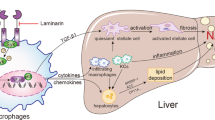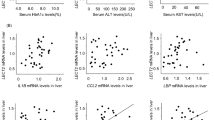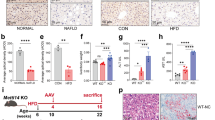Abstract
As an immune checkpoint, Tim-3 plays roles in the regulation of both adaptive and innate immune cells including macrophages and is greatly involved in chronic liver diseases. However, the precise roles of Tim-3 in nonalcoholic steatohepatitis (NASH) remain unstated. In the current study, we analyzed Tim-3 expression on different subpopulations of liver macrophages and further investigated the potential roles of Tim-3 on hepatic macrophages in methionine and choline-deficient diet (MCD)-induced NASH mice. The results of flow cytometry demonstrated the significantly increased expression of Tim-3 on all detected liver macrophage subsets in MCD mice, including F4/80+CD11b+, F4/80+CD68+, and F4/80+CD169+ macrophages. Remarkably, Tim-3 knockout (KO) significantly accelerated MCD-induced liver steatosis, displaying higher serum ALT, larger hepatic vacuolation, more liver lipid deposition, and more severe liver fibrosis. Moreover, compared with wild-type C57BL/6 mice, Tim-3 KO MCD mice demonstrated an enhanced expression of NOX2, NLRP3, and caspase-1 p20 together with increased generation of IL-1β and IL-18 in livers. In vitro studies demonstrated that Tim-3 negatively regulated the production of reactive oxygen species (ROS) and related downstream pro-inflammatory cytokine secretion of IL-1β and IL-18 in macrophages. Exogenous administration of N-Acetyl-L-cysteine (NAC), a small molecular inhibitor of ROS, remarkably suppressed caspase-1 p20 expression and IL-1β and IL-18 production in livers of Tim-3 KO mice, thus significantly reducing the severity of steatohepatitis induced by MCD. In conclusion, Tim-3 is a promising protector in MCD-induced steatohepatitis by controlling ROS and the associated pro-inflammatory cytokine production in macrophages.
This is a preview of subscription content, access via your institution
Access options
Subscribe to this journal
Receive 12 digital issues and online access to articles
$119.00 per year
only $9.92 per issue
Buy this article
- Purchase on Springer Link
- Instant access to full article PDF
Prices may be subject to local taxes which are calculated during checkout







Similar content being viewed by others
References
Loomba, R. & Sanyal, A. J. The global NAFLD epidemic. Nat. Rev. Gastroenterol. Hepatol. 10, 686–690 (2013).
Tacke, F. & Yoneyama, H. From NAFLD to NASH to fibrosis to HCC: role of dendritic cell populations in the liver. Hepatology 58, 494–496 (2013).
Tilg, H. & Moschen, A. R. Evolution of inflammation in nonalcoholic fatty liver disease: the multiple parallel hits hypothesis. Hepatology 52, 1836–1846 (2010).
Paradies, G., Paradies, V., Ruggiero, F. M. & Petrosillo, G. Oxidative stress, cardiolipin and mitochondrial dysfunction in nonalcoholic fatty liver disease. World J. Gastroenterol. 20, 14205–14218 (2014).
Spahis, S., Delvin, E., Borys, J. M. & Levy, E. Oxidative stress as a critical factor in nonalcoholic fatty liver disease pathogenesis. Antioxid. Redox Signal. 26, 519–541 (2017).
Arrese, M., Cabrera, D., Kalergis, A. M. & Feldstein, A. E. Innate Immunity and Inflammation in NAFLD/NASH. Dig. Dis. Sci. 61, 1294–1303 (2016).
Duarte, N. et al. How Inflammation Impinges on NAFLD: A Role for Kupffer Cells. BioMed. Res. Int. 2015, 984578 (2015).
Baffy, G. Kupffer cells in non-alcoholic fatty liver disease: the emerging view. J. Hepatol. 51, 212–223 (2009).
Miura, K. et al. Toll-like receptor 2 and palmitic acid cooperatively contribute to the development of nonalcoholic steatohepatitis through inflammasome activation in mice. Hepatology 57, 577–589 (2013).
Baeck, C. et al. Pharmacological inhibition of the chemokine CCL2 (MCP-1) diminishes liver macrophage infiltration and steatohepatitis in chronic hepatic injury. Gut 61, 416–426 (2012).
Monney, L. et al. Th1-specific cell surface protein Tim-3 regulates macrophage activation and severity of an autoimmune disease. Nature 415, 536–541 (2002).
Jin, H. T. et al. Cooperation of Tim-3 and PD-1 in CD8 T-cell exhaustion during chronic viral infection. Proc. Natl Acad. Sci. USA. 107, 14733–14738 (2010).
Huang, Y. H. et al. CEACAM1 regulates TIM-3-mediated tolerance and exhaustion. Nature 517, 386–390 (2015).
Han, G., Chen, G., Shen, B. & Li, Y. Tim-3: an activation marker and activation limiter of innate immune cells. Front Immunol. 4, 449 (2013).
Ocana-Guzman, R., Torre-Bouscoulet, L. & Sada-Ovalle, I. TIM-3 regulates distinct functions in macrophages. Front Immunol. 7, 229 (2016).
Zhang, Y. et al. Tim-3 negatively regulates IL-12 expression by monocytes in HCV infection. PLoS ONE 6, e19664 (2011).
Yan, W. et al. Tim-3 fosters HCC development by enhancing TGF-beta-mediated alternative activation of macrophages. Gut 64, 1593–1604 (2015).
Rong, Y. H. et al. Tim-3 expression on peripheral monocytes and CD3+ CD16/CD56+ natural killer-like T cells in patients with chronic hepatitis B. Tissue Antigens 83, 76–81 (2014).
Koh, H. S. et al. The HIF-1/glial TIM-3 axis controls inflammation-associated brain damage under hypoxia. Nat. Commun. 6, 6340 (2015).
Feng, Z. et al. Multispectral imaging of T and B cells in murine spleen and tumor. J. Immunol. 196, 3943–3950 (2016).
Alabraba, E. B. et al. A new approach to isolation and culture of human Kupffer cells. J. Immunol. Methods 326, 139–144 (2007).
Zhang, T. et al. Anti-oxidant and anti-apoptotic effects of luteolin on mice peritoneal macrophages stimulated by angiotensin II. Int. Immunopharmacol. 20, 346–351 (2014).
Young, Y. K., Bolt, A. M., Ahn, R. & Mann, K. K. Analyzing the tumor microenvironment by flow cytometry. Methods Mol. Biol. 1458, 95–110 (2016).
Maecker, H. T. & Trotter, J. Flow cytometry controls, instrument setup, and the determination of positivity. Cytometry A 69, 1037–1042 (2006).
Ju, Y. et al. T cell immunoglobulin- and mucin-domain-containing molecule-3 (Tim-3) mediates natural killer cell suppression in chronic hepatitis B. J. Hepatol. 52, 322–329 (2010).
Davies, L. C., Jenkins, S. J., Allen, J. E. & Taylor, P. R. Tissue-resident macrophages. Nat. Immunol. 14, 986–995 (2013).
Khoshbaten, M. et al. N-acetylcysteine improves liver function in patients with non-alcoholic fatty liver disease. Hepat. Mon. 10, 12–16 (2010).
Del Ben, M. et al. NOX2-generated oxidative stress is associated with severity of ultrasound liver steatosis in patients with non-alcoholic fatty liver disease. BMC Gastroenterol. 14, 81 (2014).
Arifa, R. D. et al. Inflammasome activation is reactive oxygen species dependent and mediates irinotecan-induced mucositis through IL-1beta and IL-18 in mice. Am. J. Pathol. 184, 2023–2034 (2014).
Zhang, X. et al. Reactive oxygen species-induced TXNIP drives fructose-mediated hepatic inflammation and lipid accumulation through NLRP3 inflammasome activation. Antioxid. Redox Signal. 22, 848–870 (2015).
Ye, D. et al. Toll-like receptor-4 mediates obesity-induced non-alcoholic steatohepatitis through activation of X-box binding protein-1 in mice. Gut 61, 1058–1067 (2012).
Liu, Y., Gao, L. F., Liang, X. H. & Ma, C. H. Role of Tim-3 in hepatitis B virus infection: an overview. World J. Gastroenterol. 22, 2294–2303 (2016).
Markwick, L. J. et al. Blockade of PD1 and TIM3 restores innate and adaptive immunity in patients with acute alcoholic hepatitis. Gastroenterology 148, 590–602.e10 (2015).
Zhao, D. et al. Frontline science: Tim-3-mediated dysfunctional engulfment of apoptotic cells in SLE. J. Leukoc. Biol. 102, 1313–1322 (2017).
Trocme, C. et al. Macrophage-specific NOX2 contributes to the development of lung emphysema through modulation of SIRT1/MMP-9 pathways. J. Pathol. 235, 65–78 (2015).
Ali, M. H., Messiha, B. A. & Abdel-Latif, H. A. Protective effect of ursodeoxycholic acid, resveratrol, and N-acetylcysteine on nonalcoholic fatty liver disease in rats. Pharm. Biol. 54, 1198–1208 (2016).
Tilg, H. & Diehl, A. M. Cytokines in alcoholic and nonalcoholic steatohepatitis. N. Engl. J. Med 343, 1467–1476 (2000).
Feldstein, A. E. et al. Free fatty acids promote hepatic lipotoxicity by stimulating TNF-alpha expression via a lysosomal pathway. Hepatology 40, 185–194 (2004).
Li X., et al. Helicobacter pylori induces IL-1beta and IL-18 production in human monocytic cell line through activation of NLRP3 inflammasome via ROS signaling pathway. Pathog. Dis. 73, ftu024 (2015).
Blaser, H., Dostert, C., Mak, T. W. & Brenner, D. TNF and ROS crosstalk in inflammation. Trends Cell Biol. 26, 249–261 (2016).
Wang, W. et al. Negative regulation of Nod-like receptor protein 3 inflammasome activation by T cell Ig mucin-3 protects against peritonitis. Immunology 153, 71–83 (2017).
Tosello-Trampont, A. C. et al. NKp46(+) natural killer cells attenuate metabolism-induced hepatic fibrosis by regulating macrophage activation in mice. Hepatology 63, 799–812 (2016).
Gadd, V. L. et al. The portal inflammatory infiltrate and ductular reaction in human nonalcoholic fatty liver disease. Hepatology 59, 1393–1405 (2014).
Li, Z., Soloski, M. J. & Diehl, A. M. Dietary factors alter hepatic innate immune system in mice with nonalcoholic fatty liver disease. Hepatology 42, 880–885 (2005).
Tang, Z. H. et al. Tim-3/galectin-9 regulate the homeostasis of hepatic NKT cells in a murine model of nonalcoholic fatty liver disease. J. Immunol. 190, 1788–1796 (2013).
Kadowaki, T. et al. Galectin-9 signaling prolongs survival in murine lung-cancer by inducing macrophages to differentiate into plasmacytoid dendritic cell-like macrophages. Clin. Immunol. 142, 296–307 (2012).
Oomizu, S. et al. Galectin-9 suppresses Th17 cell development in an IL-2-dependent but Tim-3-independent manner. Clin. Immunol. 143, 51–58 (2012).
Acknowledgements
This work was supported by the National Key Research and Development Program of China (2016YFE0127000), the National Natural Science Fund for Outstanding Youth Fund (81425012), the National Nature Science Foundation of China (91529305 and 81371831), and the Program for 2016ZDJS07A17.
Author information
Authors and Affiliations
Corresponding author
Ethics declarations
Competing interests
The authors declare no competing interests.
Rights and permissions
About this article
Cite this article
Du, X., Wu, Z., Xu, Y. et al. Increased Tim-3 expression alleviates liver injury by regulating macrophage activation in MCD-induced NASH mice. Cell Mol Immunol 16, 878–886 (2019). https://doi.org/10.1038/s41423-018-0032-0
Received:
Revised:
Accepted:
Published:
Issue Date:
DOI: https://doi.org/10.1038/s41423-018-0032-0
Key words
This article is cited by
-
Tim-3 protects against cisplatin nephrotoxicity by inhibiting NF-κB-mediated inflammation
Cell Death Discovery (2023)
-
T-cell Immunoglobulin and Mucin Domain 3 in Circulating Monocytes as a Novel Biomarker for Coronary Artery Disease
Journal of Cardiovascular Translational Research (2023)
-
Macrophages Serve as Bidirectional Regulators and Potential Therapeutic Targets for Liver Fibrosis
Cell Biochemistry and Biophysics (2023)
-
“Two-birds-one-stone” colon-targeted nanomedicine treats ulcerative colitis via remodeling immune microenvironment and anti-fibrosis
Journal of Nanobiotechnology (2022)
-
Tim-3+ decidual Mφs induced Th2 and Treg bias in decidual CD4+T cells and promoted pregnancy maintenance via CD132
Cell Death & Disease (2022)



